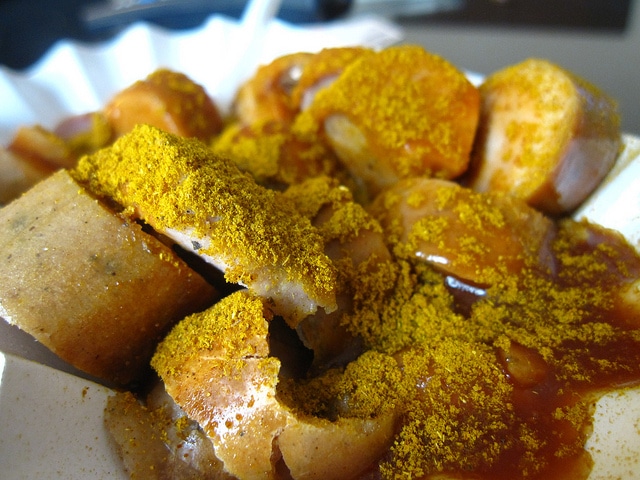
“Milwaukee has a large German population, and today I’m going to be showing you this culture through food.”
I’m currently enjoying a sample of Milwaukee Food Tours’ “Old World 3rd Street/RiverWalk Tour.” Sandy is my guide for the day, and her infectious enthusiasm for the city and apparent love of food has me excited.
We head to Old World Third Street, a three-block historic landmark zone just north of downtown. Milwaukee was founded in 1846, and German immigrants began settling in the city right away. This neighborhood is where much of this history has been retained, through traditional shops, restaurants and the detailed facades of the 19th-century European-style buildings lining this cobblestoned street that have remained over time. Today, I’ll have the chance to explore Milwaukee’s German heritage through the tongue.
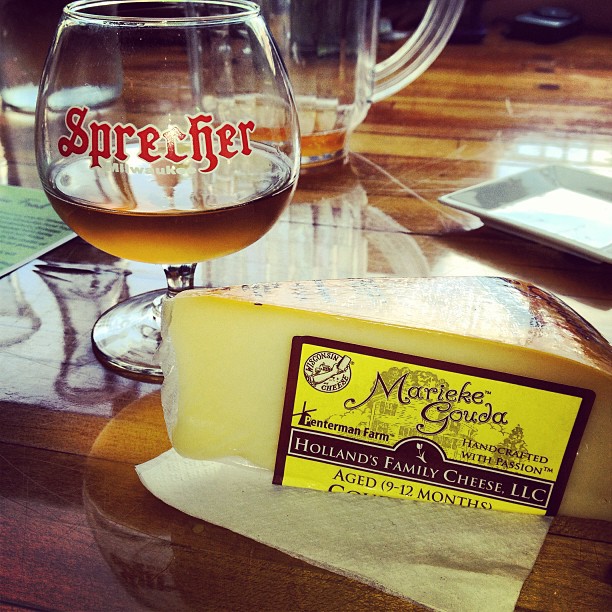
Beer and cheese pairing at the Wisconsin Cheese Mart
Cheese And Beer Pairing
Our first stop on our exploration of German influence on Milwaukee culture is the Wisconsin Cheese Mart, whose expansive cheese menu is 95% from Wisconsin. The shop is not only filled with cheeses of all shapes, sizes, colors, styles and tastes, but also free samples. My favorite is undoubtedly the fresh white cheddar cheese curds, a young, mild cheese with a firm, springy texture that causes it to squeak when you eat it. The Chocolate Walnut Fudge Cheese, which is essentially a milky chocolate fudge made with cream cheese, is also delicious, with a creamy texture and rich, sweet taste that’s undeniably satiating.
The Wisconsin Cheese Mart shares a space with Uber Tap Room, which is located through a door in the back of the shop, and we’ll be sampling an abbreviated beer and cheese tasting. We’re sipping a Wisconsinite beer from Lakefront Brewery, the only beer made with all Wisconsin ingredients, including a never-before-seen or fermented indigenous Wisconsin yeast strain. The straw-colored beer is light and refreshing and features aromas of citrus, clove and banana and a malty sweet taste. It’s paired with a Marieke Gouda from Holland’s Family Cheese, a consistent, younger cheese which gives it a satisfying creaminess. We’re also given a Bellavitano Merlot Cheese from Sartori Cheese. The queso is a cheddar Parmesan blend with a purple rind soaked in Merlot. It has a creamy mouthfeel, a crumbly texture, and well-balanced flavor. The experience reminds me that wine isn’t the only thing that can enhance a cheese tasting.

Traditional sausage at Usinger’s
Traditional Sausages
The epicurious German tour continues with a visit to Usinger’s Sausage. What makes this meat shop so unique is its passion for sticking with the same traditional recipes they’ve been using since 1880. All meats are smoked in real wood just like they were over 100 years ago. It’s also a great place to come and buy quality meats off the Seconds Table, which is where they sell meats that are of the same quality as their regular meats but too big, too small or not the most aesthetically pleasing.
Usinger’s Sausage and how it came to be is an inspiring story. In the late 1870s a young German immigrant named Fred Usinger came to Milwaukee with nothing but $400 and a book of sausage recipes. He went to work for a butcher shop owner named Julia Gaertner and, within a year, bought out the store. And although Mr. Usinger died in 1930, his legacy has lives on through the 125 varieties of old world sausages offered at the shop.
I see Sandy grab a platter of juicy looking sausages to pass around, and I’m immediately excited to taste this legacy. “What you’re sampling is our all-beef Summer Sausage and our Hickory Sticks, which are like the Slim Jim’s grandfather.”
She couldn’t have said it better. While the Summer Sausage is like a soft salami without the garlic featuring a smokey yet tangy flavor, the Hickory Sticks are firmer and are similar to a hot dog in shape. Although slender, they pack much flavor, with hints of garlic, zest and crushed red pepper.
As I munch, I can’t help but notice the painted murals that line the walls, featuring different elf-inspired scenes.
“What’s with the elves?” I ask.
Sandy smiles. “I’m glad you asked. Elves are an important part of German folklore, and store owners believed the elves would help them finish their jobs. These elves are supposed to help the Usinger’s workers finish making the sausages.”
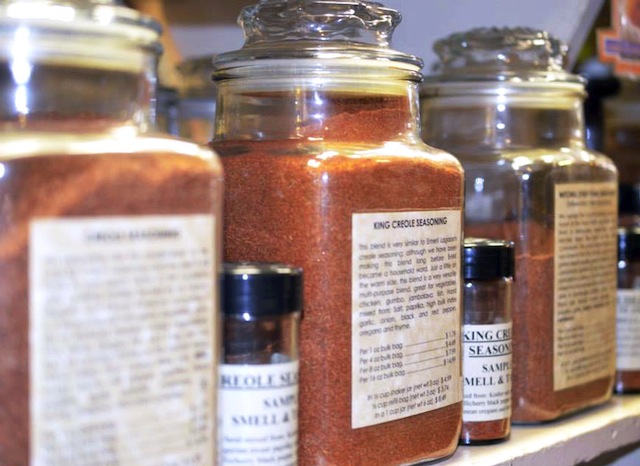
Some of the many spices at The Spice House
Spicing It Up
After Usinger’s, we make our way across the street to The Spice House, where a helpful woman named Kate tells our group about the history of the store and their spices. The Spice House focuses on purchasing their spices from the best places of origin, for example, paprika from Hungary, cardamon from India and saffron from Spain. Every three to four months they replace 99% of their expansive stock, so you can image how many shipments they must receive on a regular basis. Once the spices arrive, they’re ground on the premises and processed in small batches to create unique blends. This resonates strongly with the local German culture, as authentic German shops tend to focus on quality, handmade products. Moreover, the German diet consists of hearty meats and comfort foods bursting with flavors, and spices play a large role in making sure these dishes are up to par in terms of taste.
The tour teaches me a lot about spices. For example, the difference between an herb and a spice is that an herb is the leafy part of the plant, while the spice is the hard part. Spices — aside for coriander — are grown 15 degrees above or below the equator. Moreover, what many people refer to as “cinnamon” is actually cassia bark, and there numerous kinds. In fact, Kate leads us in a tasting.
“The only true cinnamon is Ceylon True Cinnamon,” she explains. “It’s ground from a thin, fine bark almost like parchment paper and has a complex flavor.”
We also sample Korintje Cassia Cinnamon from Indonesia, which has a pleasant spicy flavor with a slightly bitter edge; China Tunghing Cassia Cinnamon, which is rich and sweet with a natural oil to it; and Saigon Cassia Cinnamon from Vietnam, which has a reputation for being the world’s finest cinnamon and is very high in oil content, with a contrasting spicy yet sweet taste. Kate also takes us into the back room where they grind the spices by hand and keep their handwritten recipe book, as The Spice House likes to do things as they did when they opened in 1957.
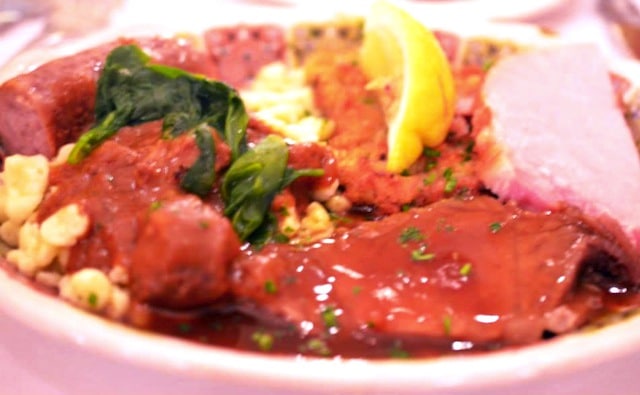
Maher’s German Sampler
A German Destination Restaurant
As if we haven’t eaten enough yet, out Milwaukee Food Tour excursion takes us to Mader’s Restaurant, a destination in itself for people from all over the world, especially celebrities and high profile individuals. As soon as you walk in the door you’ll see a list of names of past clientele, some of which include Kanye West, Justin Bierber, Britney Spears, Usher, ZZ Top, The Black Keys, Frank Sinatra, The Three Stooges, Paul Newman, Bob Hope, Alfred Hitchcock, President John F. Kennedy, President Ronald Reagan and President Gerald Ford, just to name a few.
Even more important than who Mader’s hosts is its traditional German philosophy, as the venue has been serving authentic wiener schnitzel, potato dumplings and strudel since 1902. Our meal begins with a basket of warm, salty pretzel bread that doesn’t need butter to be enjoyed, although the light, whipped spread it comes with is delicious. Next, a waitress wearing a dirndl brings one of their most popular menu items, the German Sampler. The plate features Rheinischer sauerbraten, a tender, marinated roast beef with a ginger snap sauce and golden raisins; a juicy smoked kassler rippchen pork loin; flavorful beef goulash; plump potato dumplings; and tangy red cabbage. The meal is paired with a sampling from their beer selection, a quintessential match in German culture.
Mader’s isn’t just a restaurant, it’s a museum. For one, it includes a $3 million dollar collection of art, suits of medieval armour and antiques dating back to the 14th century. As you walk around the venue, everywhere you turn you’ll find another piece of German history, right in Milwaukee.

Chocolate Lava Cake at Turner Hall
A Sweet Ending
To finish off the Milwaukee Food Tour excursion, Sandy brings us to the historic Turner Hall for dessert. A mix of High Romanesque and Queen Anne Victorian architecture, the building was completed in 1883, made of cream city brick and wood. In its beginnings it was a space for German immigrant artists to showcase their work, and was also used for concerts, dances, gymnastics competitions and theater performances. In fact, the word “turner” isn’t a family’s name, but is the German word for “gymnast.”
Today, you can still see traditional Panoramic Style murals from the early 1900s, as well as a ballroom, meeting rooms, beer hall and restaurant serving German-inspired fare made with local ingredients. This is where I find myself now, enjoying a fresh slice of chocolate lava cake and thinking back on the day and food tour. To me, a successful food excursion is one that not only leaves your tummy full and your palate satisfied, but also introduces the local culinary scene to you in a way that relates to a place’s history and culture. While I’d known Wisconsin was big on dairy, I never knew it had such a rich German culture, although I certainly did now. Sometimes, a cultural culinary experience is like a time machine, allowing you to enjoy the present but also taking you back into the past to discover an interesting facet about local heritage.
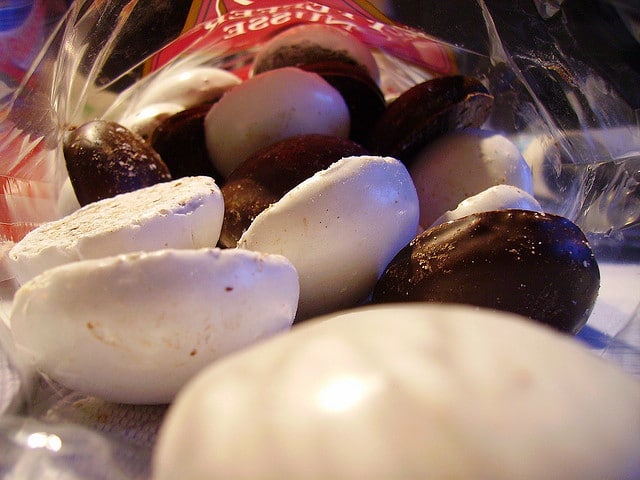
Pfeffernuesse. Photo courtesy of baumgarf.
Bringing Milwaukee’s Germany Home
One of The Spice House’s most popular recipes is a German cookie known as Pfeffernuesse. The recipe for Pfeffernuesse, meaning “Paper Nuts,” is listed on their website here (submitted by Stephanie Taylor from Corunna) which is where I got this from. You can order spices from The Spice House online to make this delicious German dessert at home. To make one pillowcase full of cookies, the recipe says:
Ingredients
2 pounds lard
2 pounds brown sugar
4 cups white sugar
3 teaspoons ground cinnamon
2 1/2 teaspoons ground cloves
2 1/2 teaspoons ground allspice
2 teaspoons ground nutmeg
2 tablespoons cassia buds (can be omitted and increase ground cinnamon by 1 teaspoon)
2 tablespoons ground cardamom
2 tablespoons ground anise seed
2 tablespoons orange peel (can be omitted)
2 cups black walnuts
2 teaspoons baking soda
1 tablespoon warm water
3 cups strong, black coffee, cold
1 handful salt
5 pounds flour
for dusting, powdered sugar
Preparation Instructions
Cream lard and sugars. Mix in spices and nuts. Combine flour with salt and add, alternating with coffee and soda water.
Dough will be stiff, almost clay like. Roll into small balls the size of nuts. Bake at 375 degrees for 10-15 minutes. Roll in powdered sugar when cool. Let age.
Helpful Hints
The flavor gets better with age. Tradition has us making these the day after Thanksgiving so they are ready for Christmas. We store them in a pillow case and hide them, so they will last until the Christmas Season.
*Note: I sampled a preview tour, not the full Riverwalk Tour. Top photo credit: Currywurst. Photo courtesy of Accidental Hedonist.

Jessica Festa is the editor of the travel sites Jessie on a Journey (http://jessieonajourney.com) and Epicure & Culture (http://epicureandculture.com). Along with blogging at We Blog The World, her byline has appeared in publications like Huffington Post, Gadling, Fodor’s, Travel + Escape, Matador, Viator, The Culture-Ist and many others. After getting her BA/MA in Communication from the State University of New York at Albany, she realized she wasn’t really to stop backpacking and made travel her full time job. Some of her most memorable experiences include studying abroad in Sydney, teaching English in Thailand, doing orphanage work in Ghana, hiking her way through South America and traveling solo through Europe. She has a passion for backpacking, adventure, hiking, wine and getting off the beaten path.








